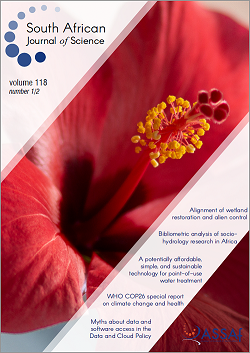Characterisation of ZnO nanoparticles prepared using aqueous leaf extracts of Chromolaena odorata (L.) and Manihot esculenta (Crantz)
DOI:
https://doi.org/10.17159/sajs.2022/11225Keywords:
cost-effective technique, ecofriendliness, zinc oxide nanoparticles, Chromolaena odorata, Manihot esculentaAbstract
Plant-mediated routes for synthesising metal oxide nanoparticles are gaining tremendous attention due to the benefits of the technique: simplicity, cost-effectiveness, and eco-friendliness. We compared the properties of zinc oxide nanoparticles (ZnONPs) made from aqueous leaf extracts of Chromolaena odorata and Manihot esculenta, both of which are abundant on the African continent. The phytochemical composition of the extracts was first assessed using gas chromatography-mass spectrometry (GC-MS) to determine the types of biomolecules involved in the reducing and capping processes that result in ZnONP formation. After that, UV-Vis spectrophotometry, scanning electron microscopy, energy dispersive X-ray analysis, transmission electron microscopy, X-ray diffractometry, and Fourier transform infrared spectroscopy (FTIR) were used to study ZnONP formation, morphological characteristics, elemental composition, shape and size properties, and phase composition. The ZnONPs made with Chromolaena odorata leaf extract had a better distribution of spherical and hexagonal forms, with an average particle size of 42.35 nm. The ZnONPs made with Manihot esculenta leaf as a reductant had a particle size of 14.71 nm on average and were more agglomerated with poor particle distribution. Phytosterols were shown to be the most important biomolecules in the reduction and capping reactions, according to GC-MS and FTIR analyses. In this study, we created a cost-effective technique for the synthesis of eco-friendly ZnONPs for diverse applications, particularly in Africa, using Chromolaena odorata and Manihot esculenta leaves.
Significance:
- This study could provide useful information on how the phytochemicals embedded in Chromolaena odorata and Manihot esculenta could influence the properties of the ZnONPs obtained from them.
- Differences in morphology and formation yield of ZnONPs are obtainable from aqueous leaf extracts of Chromolaena odorata and Manihot esculenta.
- Chromolaena odorata and Manihot esculenta could serve as dependable raw materials for the green synthesis of ZnONPs in Africa.
Published
Issue
Section
License

All articles are published under a Creative Commons Attribution 4.0 International Licence
Copyright is retained by the authors. Readers are welcome to reproduce, share and adapt the content without permission provided the source is attributed.
Disclaimer: The publisher and editors accept no responsibility for statements made by the authors
How to Cite
- Abstract 636
- PDF 988
- EPUB 533
- XML 728













.png)